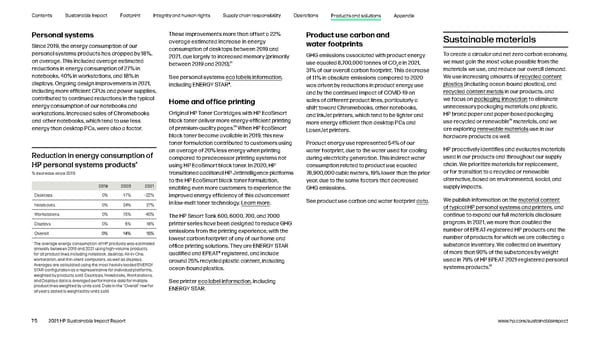Contents Sustainable Impact Footprint Integrity and human rights Supply chain responsibility Operations Products and solutions Appendix Personal systems These improvements more than offset a 22% Product use carbon and Sustainable materials Since 2019, the energy consumption of our average estimated increase in energy water footprints personal systems products has dropped by 18%, consumption of desktops between 2019 and To create a circular and net zero carbon economy, 2021, due largely to increased memory (primarily GHG emissions associated with product energy on average. This included average estimated 27 use equaled 8,700,000 tonnes of CO e in 2021, we must gain the most value possible from the reductions in energy consumption of 27% in between 2019 and 2020). 2 materials we use, and reduce our overall demand. 31% of our overall carbon footprint. This decrease notebooks, 40% in workstations, and 18% in See personal systems eco labels information, of 11% in absolute emissions compared to 2020 We use increasing amounts of recycled content displays. Ongoing design improvements in 2021, including ENERGY STAR®. was driven by reductions in product energy use plastics (including ocean-bound plastics), and including more efficient CPUs and power supplies, and by the continued impact of COVID-19 on recycled content metals in our products, and contributed to continued reductions in the typical Home and office printing sales of different product lines, particularly a we focus on packaging innovation to eliminate energy consumption of our notebooks and shift toward Chromebooks, other notebooks, unnecessary packaging materials and plastic. workstations. Increased sales of Chromebooks Original HP Toner Cartridges with HP EcoSmart and InkJet printers, which tend to be lighter and HP brand paper and paper-based packaging and other notebooks, which tend to use less black toner deliver more energy-efficient printing use recycled or renewable29 more energy efficient than desktop PCs and materials, and we 28 energy than desktop PCs, were also a factor. of premium-quality pages. When HP EcoSmart LaserJet printers. are exploring renewable materials use in our black toner became available in 2019, this new hardware products as well. toner formulation contributed to customers using Product energy use represented 54% of our Reduction in energy consumption of an average of 20% less energy when printing water footprint, due to the water used for cooling HP proactively identifies and evaluates materials compared to predecessor printing systems not during electricity generation. This indirect water used in our products and throughout our supply HP personal systems products* using HP EcoSmart black toner. In 2020, HP consumption related to product use equaled chain. We prioritize materials for replacement, % decrease since 2019 transitioned additional HP JetIntelligence platforms 78,900,000 cubic meters, 19% lower than the prior or for transition to a recycled or renewable to the HP EcoSmart black toner formulation, year, due to the same factors that decreased alternative, based on environmental, social, and 2019 2020 2021 enabling even more customers to experience the GHG emissions. supply impacts. Desktops 0% -17% -22% improved energy efficiency of this advancement in low-melt toner technology. Learn more. See product use carbon and water footprint data. We publish information on the material content Notebooks 0% 24% 27% of typical HP personal systems and printers, and Workstations 0% 15% 40% The HP Smart Tank 600, 6000, 700, and 7000 continue to expand our full materials disclosure Displays 0% 6% 18% printer series have been designed to reduce GHG program. In 2021, we more than doubled the Overall 0% 14% 18% emissions from the printing experience, with the number of EPEAT-registered HP products and the lowest carbon footprint of any of our home and number of products for which we are collecting a * The average energy consumption of HP products was estimated office printing solutions. They are ENERGY STAR substance inventory. We collected an inventory annually between 2019 and 2021 using high-volume products qualified and EPEAT® registered, and include of more than 90% of the substances by weight for all product lines including notebook, desktop, All-in-One, workstation, and thin client computers, as well as displays. around 25% recycled plastic content, including used in 79% of HP EPEAT 2021-registered personal Averages are calculated using the most heavily loaded ENERGY 30 STAR configuration as a representative for individual platforms, ocean-bound plastics. systems products. weighted by products sold. Desktops, Notebooks, Workstations, and Displays data is averaged performance data for multiple See printer eco label information, including product lines weighted by units sold. Data in the “Overall” row for ENERGY STAR. all years stated is weighted by units sold. 75 2021 HP Sustainable Impact Report www.hp.com/sustainableimpact
 HP Sustainable Impact Report Page 74 Page 76
HP Sustainable Impact Report Page 74 Page 76